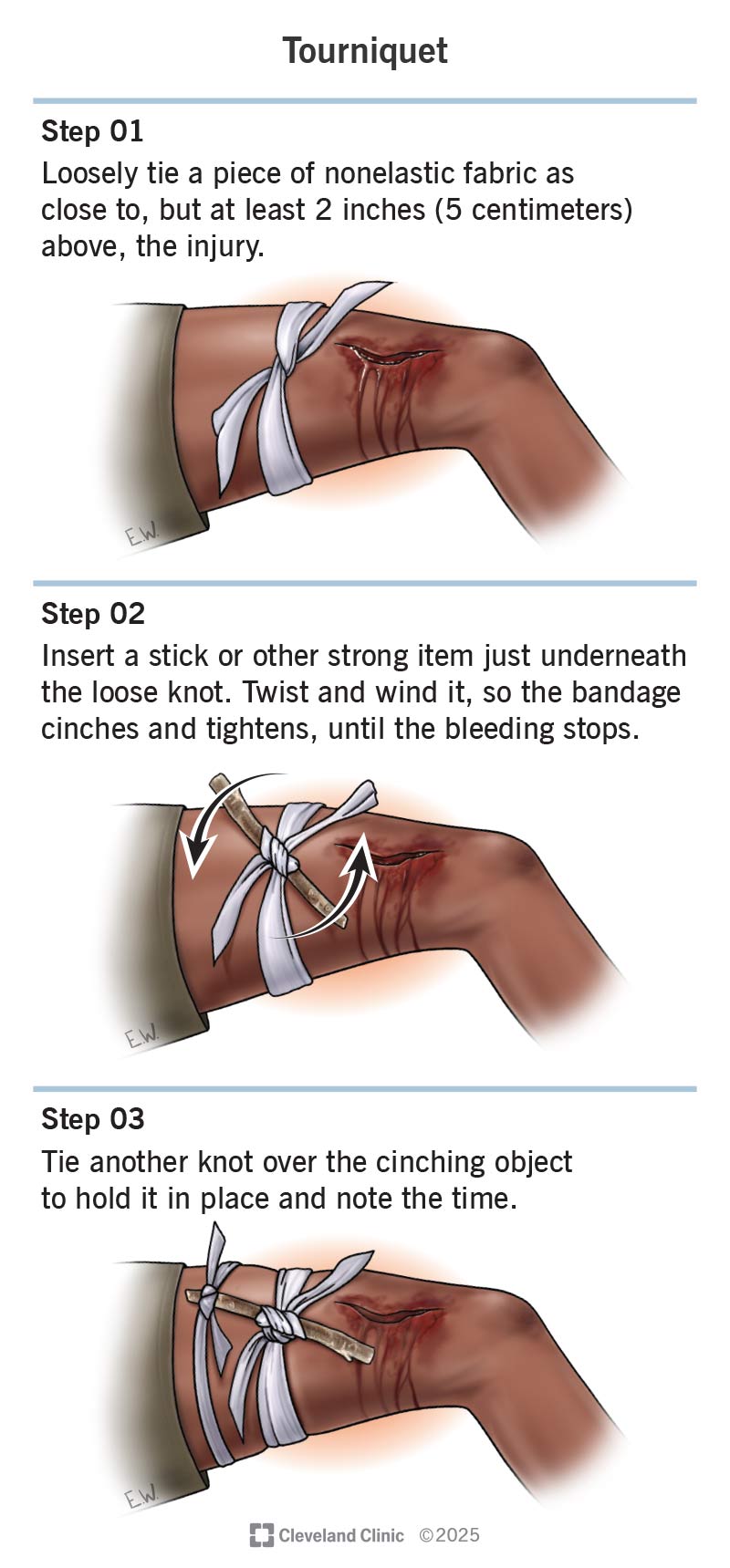When life-threatening bleeding happens, one way to stop it is to cut off circulation to the affected body part. Tourniquets are a way to do that if the bleeding is happening on an arm or leg. But despite what you see on TV or in movies, using tourniquets isn’t common. And knowing how and when to use — or not use — them can be just as lifesaving.
Advertisement
Cleveland Clinic is a non-profit academic medical center. Advertising on our site helps support our mission. We do not endorse non-Cleveland Clinic products or services. Policy

A tourniquet is a medical device that puts enough pressure on a body part to stop blood from flowing past it, cutting off circulation. Tourniquets are often a part of routine care in medical settings like surgeries. But outside of medical settings, tourniquets can be a lifesaving treatment for severe blood loss.
Advertisement
Cleveland Clinic is a non-profit academic medical center. Advertising on our site helps support our mission. We do not endorse non-Cleveland Clinic products or services. Policy
Severe blood loss (hemorrhage) is a life-threatening medical emergency. If you lose too much blood, you can go into shock. The first option to stop bleeding is to put direct pressure on the wound until bleeding stops. But sometimes, that isn’t possible. Some examples of that include if:
First responders may also use tourniquets in mass casualty events, where quick action is necessary to save as many lives as possible. And in some cases, they may also use a tourniquet as a temporary measure to buy time while they do CPR or other critical lifesaving treatments.
WARNING: Only use a tourniquet as a last option or in extreme situations. Before using a tourniquet, you should try the following:
Advertisement
Many tourniquets come with instructions on how to use them. It’s best to use them only if you have training, like a first aid class. But in a life-or-death situation, you can improvise a tourniquet using a nonelastic piece of fabric or cloth. This is known as an improvised or Russian tourniquet. You should start with placement, remembering the following:
Once you have the placement right, use the Spanish windlass technique to tighten the bandage until the bleeding stops. Once the bleeding stops, tie another knot over the cinching object to hold it in place.
Make sure to note the time you tie the final knot. Medical professionals will need to know that time when they take over treatment. And be absolutely certain they know about the tourniquet. Don’t automatically expect them to see and recognize it.
Once you’re sure you’ve stopped the bleeding, call 911 (or your local emergency services number) if someone hasn’t done so already. The faster a person with a tourniquet gets professional medical care, the more likely a positive outcome.
Manufactured tourniquets, made for exactly that purpose, are best when available. If you have to improvise, remember the following
Tourniquets save lives when used properly. The downside of a tourniquet is that it cuts off circulation to parts of the limb below it. While that stops dangerous bleeding, it can also lead to damage from lack of blood flow (ischemia). And if ischemia lasts too long, the affected limb might need amputation.
Tourniquets can remain in place without permanent damage for up to two hours under ordinary conditions. But tourniquets should be as temporary as possible, so emergency medical care for them is always critical.
Yes, but only with professional supervision. Many first aid classes led by trained, certified instructors can teach you how to use them. Local nonprofit groups, healthcare organizations and first responder departments often host them.
Tourniquets save lives, but they shouldn’t be your first choice for stopping bleeding. First aid training can make a huge difference for you and others. And many programs that teach first aid include lessons on how to use tourniquets properly and safely. Training programs like these are often available at low or no cost. That training can empower you to help others and yourself in times of need. And with training, you’ll be in a better position to judge when and if you should use a tourniquet to help someone in need.
Advertisement
Whether you need stitches, a broken bone set or think your appendix might be causing your abdominal pain, Cleveland Clinic’s emergency medicine team is here to help.

Last reviewed on 06/12/2025.
Learn more about the Health Library and our editorial process.